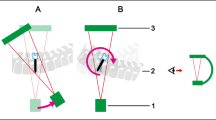Abstract
Study design
Three imaging techniques were compared using porcine spines.
Objectives
To compare image acquisition time, radiation exposure, pedicle width measurement, assessment of screw breach, and image artifact between cone-beam tomosynthesis (CBT) single mode, CBT dual mode (stereotactic CBT), and computed tomography (CT) imaging with and without spinal implants.
Summary of background data
CT is the standard for axial imaging of orthopedic procedures. CBT technology is being developed, allowing real-time intraoperative imaging and 3D surgical guidance. CBT may deliver useful axial imaging quicker with less radiation than current technologies.
Methods
Six porcine spines were instrumented with bilateral pedicle screws at six levels connected with 5.5 mm rods. Dosimeters were attached to four surfaces of spines. CT, CBT single and CBT dual images were acquired pre-implant and post-implant. Image acquisition and 3D reconstruction times were recorded. Pedicle widths were measured before and after instrumentation. Screw medial breaches were graded (0: no breach, 1: < 2 mm, 2: 2–4 mm, 3: > 4 mm). Artifact and/or distortion of each image was ranked (0 = none, 1 = mild, 2 = moderate, 3 = large). Image acquisition and reconstruction times, radiation dose, pedicle width, screw breach and artifact were compared between techniques.
Results
Total image acquisition and reconstruction times of CBT was significantly less (single: 9.9 ± 0.2 s, p < 0.001; dual: 60.0 ± 8.7 s, p < 0.001) than CT (250.3 ± 36.7 s). CBT had significantly less radiation exposure than CT (CT: 0.7 ± 0.1 rad, single: 0.03 ± 0.02 rad, dual: 0.07 ± 0.03 rad; p < 0.001). No difference in pedicle width change pre-implant to post-implant was found (CT: p = 0.449, single: p = 0.430, dual: p = 0.528). Pedicle width (pre-implant: p > 0.5, post-implant: p > 0.9) and pedicle width change (p > 0.4) was similar amongst all techniques. Breach assessment was not different between groups (p = 0.257). CBT images had consistently lower artifact grades than CT.
Conclusions
Although CBT axial image quality appeared subjectively inferior to CT, it enabled consistent assessment of pedicle width and screw breach, at half time and 10× lower radiation exposure. With continued refinements, CBT technology may allow for adequate intra-operative axial imaging using low radiation exposure.









Similar content being viewed by others
References
Goodman TR, Mustafa A, Rowe E (2019) Pediatric CT radiation exposure: where we were, and where we are now. Pediatr Radiol 49:469–478
Brenner DJ, Hall EJ (2007) Computed tomography—an increasing source of radiation exposure. N Engl J Med 357:2277–2284
Brenner DJ (2010) Should we be concerned about the rapid increase in CT usage? Rev Environ Health 25:63–68
Hadelsberg UP, Harel R (2016) Hazards of ionizing radiation and its impact on spine surgery. World Neurosurg 92:353–359
Urakov TM (2018) Practical assessment of radiation exposure in spine surgery. World Neurosurg 120:e752–e754
Laudato PA, Pierzchala K, Schizas C (2018) Pedicle screw insertion accuracy using o-arm, robotic guidance, or freehand technique: a comparative study. Spine 43:E373–E378
Conger A, Shah L, Shah V, McCormick Z (2020) Cone beam tomosynthesis: an emerging technology for procedural image guidance. Pain Med. https://doi.org/10.1093/pm/pnz340(Online ahead of print)
Atria C, Noo F, Keiriz J, Packard N, Last L (2017) Assessment of a novel real-time cone beam tomosynthesis (cbt) X-ray scanner. Med Phys 44:3013
Atria C, Last L, Packard N, Noo F (2018) Cone beam tomosynthesis fluoroscopy: a new approach to 3D image guidance. In: Medical imaging: image-guided procedures, robotic interventions, and modeling 105762018:105762V. International Society for Optics and Photonics
Balaguru D, Rodriguez M, Leon S, Wagner LK, Beasley CW, Sultzer A (2018) Numan MT comparison of skin dose measurement using nanoDot. Ann Pediatr Cardiol 11:12–16
Ben Abdennebi A, Aubry S, Ounalli L, Fayache MS, Delabrousse E, Petegnief Y (2017) Comparative dose levels between CT-scanner and slot-scanning device (EOS system) in pregnant women pelvimetry. Phys Med 33:77–86
Ding GX, Malcolm AW (2013) An optically stimulated luminescence dosimeter for measuring patient exposure from imaging guidance procedures. Phys Med Biol 58:5885–5897
Rampersaud YR, Pik JH, Salonen D, Farooq S (2005) Clinical accuracy of fluoroscopic computer-assisted pedicle screw fixation: a CT analysis. Spine 30:E183–190
Acknowledgements
Tracey P. Bastrom, MS for statistical analysis.
Funding
nView medical (Salt Lake City, UT) funded the study in part and provided use of imaging equipment, software and radiolucent table. Additional support was from the Orthopedic Division, Children’s Specialists of San Diego. Grant of use of spinal implants and instrumentation from OrthoPediatrics, Warsaw, IN.
Author information
Authors and Affiliations
Contributions
VU, CF—Design; Data acquisition, analysis and/or interpretation of work; Manuscript drafting and/or critically revising. Final approval of submitted manuscript. HB—Data acquisition, analysis and/or interpretation of work; Manuscript drafting and/or critically revising. Final approval of submitted manuscript.
Corresponding author
Additional information
Publisher's Note
Springer Nature remains neutral with regard to jurisdictional claims in published maps and institutional affiliations.
Rights and permissions
About this article
Cite this article
Upasani, V.V., Bandaralage, H. & Farnsworth, C.L. 3D cone-beam tomosynthesis provides axial imaging of the spine with lower radiation compared to computed tomography. Spine Deform 9, 41–49 (2021). https://doi.org/10.1007/s43390-020-00199-x
Received:
Accepted:
Published:
Issue Date:
DOI: https://doi.org/10.1007/s43390-020-00199-x




